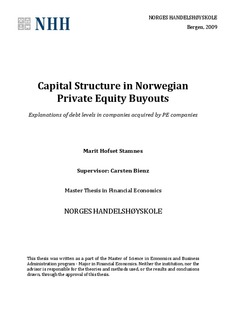Capital structure in Norwegian private equity buyouts : explanations of debt levels in companies acquired by PE companies
Master thesis
Permanent lenke
http://hdl.handle.net/11250/169023Utgivelsesdato
2009Metadata
Vis full innførselSamlinger
- Master Thesis [4372]
Sammendrag
This thesis analyzes the capital structure in companies acquired by Private Equity companies
in the period 1997 to 2007 in Norway.
The purpose of the analysis is to see whether debt ratios in the companies that have been
acquired by PE companies increase after the year they were acquired compared to the two
years before the acquisition. Secondly, the thesis analyses whether the capital structure,
specifically the debt levels in companies that have been acquired by PE companies could be
explained by other company or market characteristics than what is commonly said to explain
debt levels in companies. Finally, the thesis tests whether there is a relationship between the
debt ratios and the General Partner commitment as percentage of average personal wealth.
The results show that the differences between debt ratios in the years after the acquisition and
the years before the acquisition are not statistically significantly different from zero, and thus
one cannot infer that the companies have larger debt ratios after the acquisition than before
the acquisition.
Secondly, the analysis of the sample shows that size measured by sales revenue and
profitability measured by EBITDA both are positively related to debt levels, implying that
larger companies and companies that are more profitable have larger debt levels. Further, the
analysis show that there is a negative relationship between asset tangibility and debt levels,
which implies that companies with high asset tangibility have lower debt levels. The analysis
showed also that there is a positive relationship between investment year and debt levels,
which could be interpreted that debt levels have been increasing since 1997 and until 2007.
Finally, the analysis showed that there is a negative relationship between General Partner
commitments as percentage of average wealth per partner and General Partner commitments
as percentage of average wealth per professional in the PE company, which implies that in
this model, the debt levels decrease when General Partner commitment percentages increases.
Based on this, one can infer that General Partners who invest a larger portion of their personal
wealth in the fund, take on less risk in the buyout process by having lower debt levels.
